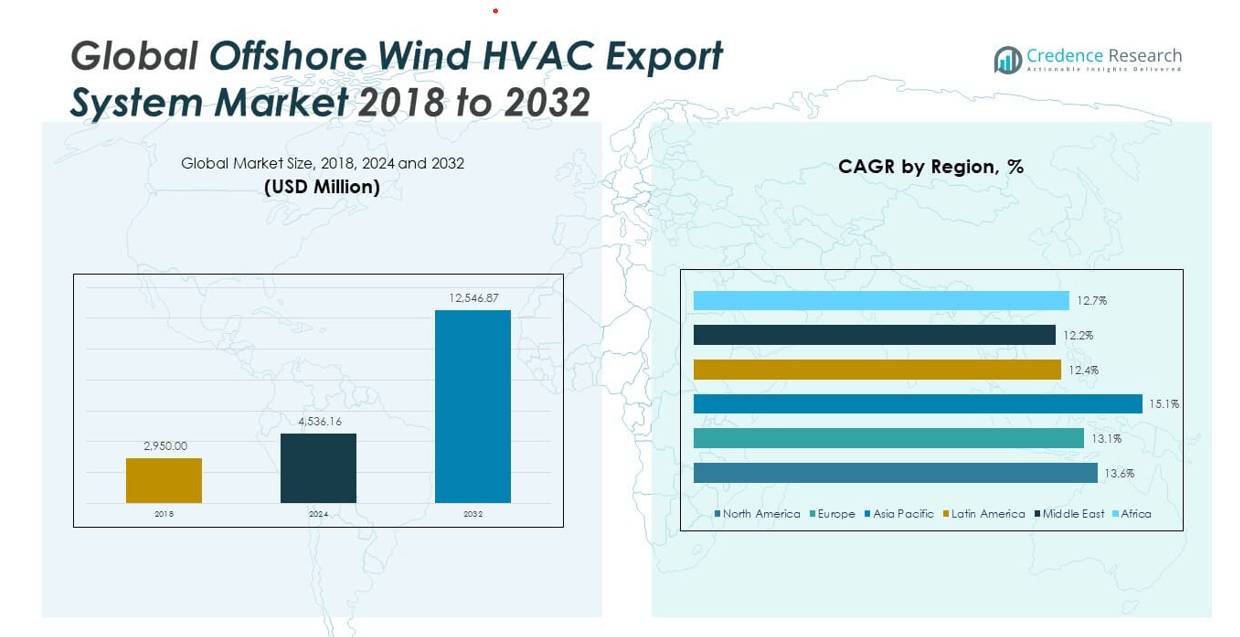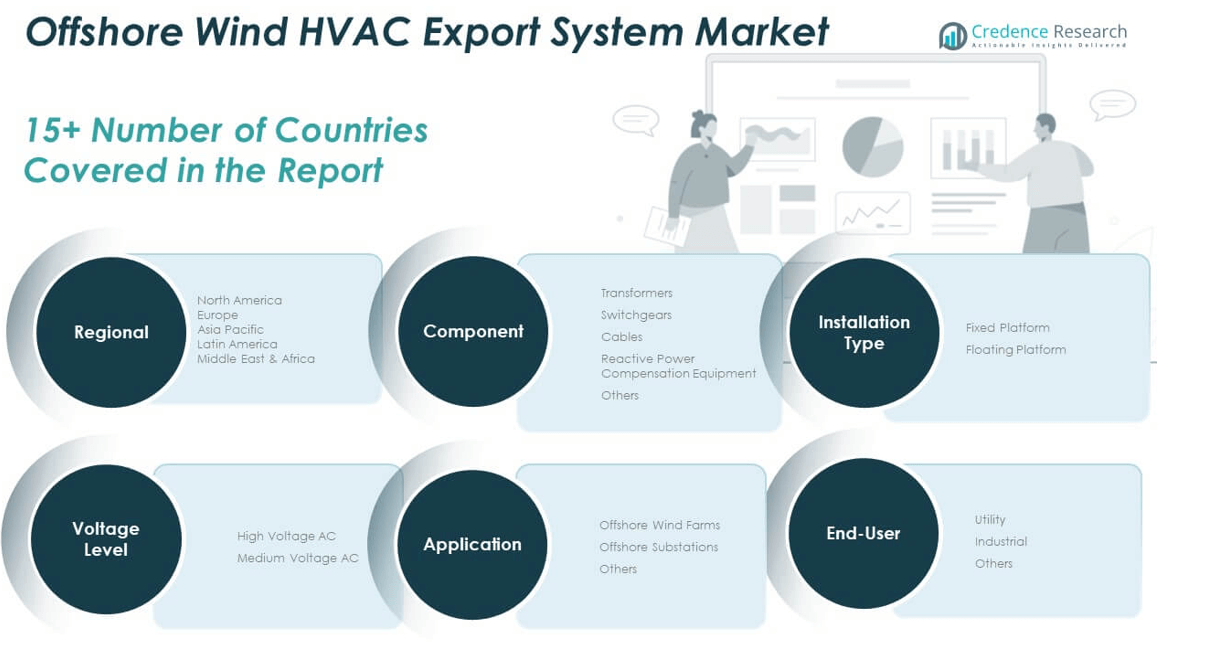CHAPTER NO. 1 : GENESIS OF THE MARKET
1.1 Market Prelude – Introduction & Scope
1.2 The Big Picture – Objectives & Vision
1.3 Strategic Edge – Unique Value Proposition
1.4 Stakeholder Compass – Key Beneficiaries
CHAPTER NO. 2 : EXECUTIVE LENS
2.1 Pulse of the Industry – Market Snapshot
2.2 Growth Arc – Revenue Projections (USD Million)
2.3. Premium Insights – Based on Primary Interviews
CHAPTER NO. 3 : OFFSHORE WIND HVAC EXPORT SYSTEM MARKET FORCES & INDUSTRY PULSE
3.1 Foundations of Change – Market Overview
3.2 Catalysts of Expansion – Key Market Drivers
3.2.1 Momentum Boosters – Growth Triggers
3.2.2 Innovation Fuel – Disruptive Technologies
3.3 Headwinds & Crosswinds – Market Restraints
3.3.1 Regulatory Tides – Compliance Challenges
3.3.2 Economic Frictions – Inflationary Pressures
3.4 Untapped Horizons – Growth Potential & Opportunities
3.5 Strategic Navigation – Industry Frameworks
3.5.1 Market Equilibrium – Porter’s Five Forces
3.5.2 Ecosystem Dynamics – Value Chain Analysis
3.5.3 Macro Forces – PESTEL Breakdown
3.6 Price Trend Analysis
3.6.1 Regional Price Trend
3.6.2 Price Trend by product
CHAPTER NO. 4 : KEY INVESTMENT EPICENTER
4.1 Regional Goldmines – High-Growth Geographies
4.2 Product Frontiers – Lucrative Product Categories
4.3 Application Sweet Spots – Emerging Demand Segments
CHAPTER NO. 5: REVENUE TRAJECTORY & WEALTH MAPPING
5.1 Momentum Metrics – Forecast & Growth Curves
5.2 Regional Revenue Footprint – Market Share Insights
5.3 Segmental Wealth Flow – Component & Application Revenue
CHAPTER NO. 6 : TRADE & COMMERCE ANALYSIS
6.1. Import Analysis by Region
6.1.1. Global Offshore Wind HVAC Export System Market Import Revenue By Region
6.2. Export Analysis by Region
6.2.1. Global Offshore Wind HVAC Export System Market Export Revenue By Region
CHAPTER NO. 7 : COMPETITION ANALYSIS
7.1. Company Market Share Analysis
7.1.1. Global Offshore Wind HVAC Export System Market: Company Market Share
7.2. Global Offshore Wind HVAC Export System Market Company Revenue Market Share
7.3. Strategic Developments
7.3.1. Acquisitions & Mergers
7.3.2. New Product Launch
7.3.3. Regional Expansion
7.4. Competitive Dashboard
7.5. Company Assessment Metrics, 2024
CHAPTER NO. 8 : OFFSHORE WIND HVAC EXPORT SYSTEM MARKET – BY COMPONENT SEGMENT ANALYSIS
8.1. Offshore Wind HVAC Export System Market Overview by Component Segment
8.1.1. Offshore Wind HVAC Export System Market Revenue Share By Component
8.2. Transformers
8.3. Switchgears
8.4. Cables
8.5. Reactive Power Compensation Equipment
8.6. Others
CHAPTER NO. 9 : Offshore Wind HVAC Export System MARKET – BY APPLICATION SEGMENT ANALYSIS
9.1. Offshore Wind HVAC Export System Market Overview by Application Segment
9.1.1. Offshore Wind HVAC Export System Market Revenue Share By Application
9.2. Offshore Wind Farms
9.3. Offshore Substations
9.4. Others
CHAPTER NO. 10 : OFFSHORE WIND HVAC EXPORT SYSTEM MARKET – BY END-USER SEGMENT ANALYSIS
10.1. Offshore Wind HVAC Export System Market Overview by End-user Segment
10.1.1. Offshore Wind HVAC Export System Market Revenue Share By End-user
10.2. Utility
10.3. Industrial
10.4. Others
CHAPTER NO. 11 : OFFSHORE WIND HVAC EXPORT SYSTEM MARKET – BY INSTALLATION TYPE SEGMENT ANALYSIS
11.1. Offshore Wind HVAC Export System Market Overview by Installation Type Segment
11.1.1. Offshore Wind HVAC Export System Market Revenue Share By Installation Type
11.2. Fixed Platform
11.3. Floating Platform
CHAPTER NO. 12 : OFFSHORE WIND HVAC EXPORT SYSTEM MARKET – BY VOLTAGE LEVEL SEGMENT ANALYSIS
12.1. Offshore Wind HVAC Export System Market Overview by Voltage Level Segment
12.1.1. Offshore Wind HVAC Export System Market Revenue Share By Voltage Level
12.2. High Voltage AC
12.3. Medium Voltage AC
CHAPTER NO. 13 : OFFSHORE WIND HVAC EXPORT SYSTEM MARKET – REGIONAL ANALYSIS
13.1. Offshore Wind HVAC Export System Market Overview by Region Segment
13.1.1. Global Offshore Wind HVAC Export System Market Revenue Share By Region
13.1.2. Regions
13.1.3. Global Offshore Wind HVAC Export System Market Revenue By Region
13.1.4. Component
13.1.5. Global Offshore Wind HVAC Export System Market Revenue By Component
13.1.6. Application
13.1.7. Global Offshore Wind HVAC Export System Market Revenue By Application
13.1.8. End-user
13.1.9. Global Offshore Wind HVAC Export System Market Revenue By End-user
13.1.10. Installation Type
13.1.12. Global Offshore Wind HVAC Export System Market Revenue By Installation Type
13.1.13. Voltage Level
13.1.14. Global Offshore Wind HVAC Export System Market Revenue By Voltage Level
CHAPTER NO. 14 : NORTH AMERICA OFFSHORE WIND HVAC EXPORT SYSTEM MARKET – COUNTRY ANALYSIS
14.1. North America Offshore Wind HVAC Export System Market Overview by Country Segment
14.1.1. North America Offshore Wind HVAC Export System Market Revenue Share By Region
14.2. North America
14.2.1. North America Offshore Wind HVAC Export System Market Revenue By Country
14.2.2. Component
14.2.3. North America Offshore Wind HVAC Export System Market Revenue By Component
14.2.4. Application
14.2.5. North America Offshore Wind HVAC Export System Market Revenue By Application
14.2.6. End-user
14.2.7. North America Offshore Wind HVAC Export System Market Revenue By End-user
14.2.8. Installation Type
14.2.9. North America Offshore Wind HVAC Export System Market Revenue By Installation Type
14.2.10. Voltage Level
14.2.11. North America Offshore Wind HVAC Export System Market Revenue By Voltage Level
14.3. U.S.
14.4. Canada
14.5. Mexico
CHAPTER NO. 15 : EUROPE OFFSHORE WIND HVAC EXPORT SYSTEM MARKET – COUNTRY ANALYSIS
15.1. Europe Offshore Wind HVAC Export System Market Overview by Country Segment
15.1.1. Europe Offshore Wind HVAC Export System Market Revenue Share By Region
15.2. Europe
15.2.1. Europe Offshore Wind HVAC Export System Market Revenue By Country
15.2.2. Component
15.2.3. Europe Offshore Wind HVAC Export System Market Revenue By Component
15.2.4. Application
15.2.5. Europe Offshore Wind HVAC Export System Market Revenue By Application
15.2.6. End-user
15.2.7. Europe Offshore Wind HVAC Export System Market Revenue By End-user
15.2.8. Installation Type
15.2.9. Europe Offshore Wind HVAC Export System Market Revenue By Installation Type
15.2.10. Voltage Level
15.2.11. Europe Offshore Wind HVAC Export System Market Revenue By Voltage Level
15.3. UK
15.4. France
15.5. Germany
15.6. Italy
15.7. Spain
15.8. Russia
15.9. Rest of Europe
CHAPTER NO. 16 : ASIA PACIFIC OFFSHORE WIND HVAC EXPORT SYSTEM MARKET – COUNTRY ANALYSIS
16.1. Asia Pacific Offshore Wind HVAC Export System Market Overview by Country Segment
16.1.1. Asia Pacific Offshore Wind HVAC Export System Market Revenue Share By Region
16.2. Asia Pacific
16.2.1. Asia Pacific Offshore Wind HVAC Export System Market Revenue By Country
16.2.2. Component
16.2.3. Asia Pacific Offshore Wind HVAC Export System Market Revenue By Component
16.2.4. Application
16.2.5. Asia Pacific Offshore Wind HVAC Export System Market Revenue By Application
16.2.6. End-user
16.2.7. Asia Pacific Offshore Wind HVAC Export System Market Revenue By End-user
16.2.8. Installation Type
16.2.9. Asia Pacific Offshore Wind HVAC Export System Market Revenue By Installation Type
16.2.10. Voltage Level
16.2.11. Asia Pacific Offshore Wind HVAC Export System Market Revenue By Voltage Level
16.3. China
16.4. Japan
16.5. South Korea
16.6. India
16.7. Australia
16.8. Southeast Asia
16.9. Rest of Asia Pacific
CHAPTER NO. 17 : LATIN AMERICA OFFSHORE WIND HVAC EXPORT SYSTEM MARKET – COUNTRY ANALYSIS
17.1. Latin America Offshore Wind HVAC Export System Market Overview by Country Segment
17.1.1. Latin America Offshore Wind HVAC Export System Market Revenue Share By Region
17.2. Latin America
17.2.1. Latin America Offshore Wind HVAC Export System Market Revenue By Country
17.2.2. Component
17.2.3. Latin America Offshore Wind HVAC Export System Market Revenue By Component
17.2.4. Application
17.2.5. Latin America Offshore Wind HVAC Export System Market Revenue By Application
17.2.6. End-user
17.2.7. Latin America Offshore Wind HVAC Export System Market Revenue By End-user
17.2.8. Installation Type
17.2.9. Latin America Offshore Wind HVAC Export System Market Revenue By Installation Type
17.2.10. Voltage Level
17.2.11. Latin America Offshore Wind HVAC Export System Market Revenue By Voltage Level
17.3. Brazil
17.4. Argentina
17.5. Rest of Latin America
CHAPTER NO. 18 : MIDDLE EAST OFFSHORE WIND HVAC EXPORT SYSTEM MARKET – COUNTRY ANALYSIS
18.1. Middle East Offshore Wind HVAC Export System Market Overview by Country Segment
18.1.1. Middle East Offshore Wind HVAC Export System Market Revenue Share By Region
18.2. Middle East
18.2.1. Middle East Offshore Wind HVAC Export System Market Revenue By Country
18.2.2. Component
18.2.3. Middle East Offshore Wind HVAC Export System Market Revenue By Component
18.2.4. Application
18.2.5. Middle East Offshore Wind HVAC Export System Market Revenue By Application
18.2.6. End-user
18.2.7. Middle East Offshore Wind HVAC Export System Market Revenue By End-user
18.2.8. Installation Type
18.2.9. Middle East Offshore Wind HVAC Export System Market Revenue By Installation Type
18.2.10. Voltage Level
18.2.11. Middle East Offshore Wind HVAC Export System Market Revenue By Voltage Level
18.3. GCC Countries
18.4. Israel
18.5. Turkey
18.6. Rest of Middle East
CHAPTER NO. 19 : AFRICA OFFSHORE WIND HVAC EXPORT SYSTEM MARKET – COUNTRY ANALYSIS
19.1. Africa Offshore Wind HVAC Export System Market Overview by Country Segment
19.1.1. Africa Offshore Wind HVAC Export System Market Revenue Share By Region
19.2. Africa
19.2.1. Africa Offshore Wind HVAC Export System Market Revenue By Country
19.2.2. Component
19.2.3. Africa Offshore Wind HVAC Export System Market Revenue By Component
19.2.4. Application
19.2.5. Africa Offshore Wind HVAC Export System Market Revenue By Application
19.2.6. End-user
19.2.7. Africa Offshore Wind HVAC Export System Market Revenue By End-user
19.2.8. Installation Type
19.2.9. Africa Offshore Wind HVAC Export System Market Revenue By Installation Type
19.2.10. Voltage Level
19.2.11. Africa Offshore Wind HVAC Export System Market Revenue By Voltage Level
19.3. South Africa
19.4. Egypt
19.5. Rest of Africa
CHAPTER NO. 20 : COMPANY PROFILES
20.1. Siemens Energy
20.1.1. Company Overview
20.1.2. Product Portfolio
20.1.3. Financial Overview
20.1.4. Recent Developments
20.1.5. Growth Strategy
20.1.6. SWOT Analysis
20.2. ABB
20.3. GE Grid Solutions
20.4. NKT A/S
20.5. Prysmian Group
20.6. Nexans
20.7. LS Cable & System
20.8. Sumitomo Electric Industries
20.9. Hitachi Energy
20.10. JDR Cable Systems
20.11. ZTT Group
20.12. Furukawa Electric
20.13. Hellenic Cables
20.14. Taihan Electric Wire
20.15. Trelleborg Group
20.16. Boskalis
20.17. Royal Boskalis Westminster
20.18. Hengtong Group
20.19. Orient Cable (NBO)









